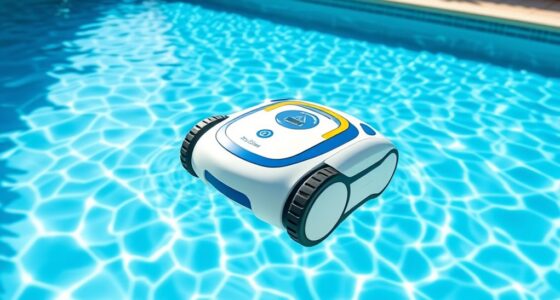Start by checking for leaks in your plumbing, as these can cause low water pressure. Clean or replace clogged faucet aerators and showerheads to improve flow. Make sure your main water valve is fully open and inspect for any obstructions. Examine pipes for blockages or corrosion, and test the water pressure regulator if you have one. External factors like municipal supply issues may also play a role. Keep exploring to find the best solution for your home.
Key Takeaways
- Check for leaks or pipe corrosion that may cause pressure drops underground or within the plumbing system.
- Inspect and clean faucet aerators and showerheads to remove mineral buildup restricting flow.
- Verify that the main water valve and pressure regulator are fully open and functioning correctly.
- Look for external factors like municipal supply issues, scheduled maintenance, or infrastructure damage affecting pressure.
- Contact a professional plumber if leak repairs, regulator adjustments, or external assessments are needed.
Check for Leaks in Your Plumbing System

Leaks in your plumbing system can considerably reduce water pressure, so it’s vital to identify and fix them promptly. One common cause is pipe corrosion, which weakens pipes and creates tiny holes, leading to leaks. These deteriorated pipes often develop underground leaks that are hard to spot but can substantially impact water flow. Look for signs like damp spots on walls or ceilings, unexplained increases in your water bill, or reduced water flow from fixtures. If you notice these issues, inspect exposed pipes for corrosion or wet areas that might indicate leaks. Regular maintenance, including inspecting for fire safety hazards, can also help prevent issues that affect your plumbing. For underground leaks, consider hiring a professional who can perform pressure tests or use specialized equipment to locate hidden leaks. Addressing these leaks early prevents further damage and restores your water pressure.
Inspect and Clean Faucet Aerators and Showerheads

Start by removing the faucet aerators and showerheads to check for mineral buildup or debris. Disassemble the fixtures carefully, then clean or replace any clogged components. This simple step can often restore proper water flow and improve pressure. For ongoing issues, inspecting the water filtration system can help identify if additional blockages are affecting water pressure.
Removing and Disassembling Components
To improve water flow, you should begin by removing and disassembling your faucet aerators and showerheads for inspection and cleaning. Start with component removal by unscrewing these fixtures carefully. Disassembling fixtures allows you to access internal parts that may be clogged or mineral buildup. Use a wrench or your hands to detach the aerator or showerhead from the pipe. Once removed, take apart the components to inspect for debris or blockages. Be mindful of small parts like screens or washers. Removing and disassembling fixtures properly ensures you can thoroughly clean or replace parts as needed. This step is vital in restoring proper water pressure and preventing future flow issues caused by buildup or obstructions. Additionally, applying proper maintenance techniques can help sustain optimal water flow over time.
Cleaning and Replacing Fixtures
Cleaning and replacing fixtures is a crucial step in restoring proper water pressure. Over time, mineral buildup from hard water can clog faucet aerators and showerheads, reducing flow. Start by turning off the water supply and removing these fixtures. Inspect them for debris and mineral deposits. Soak the aerators and showerheads in vinegar to dissolve buildup, then scrub gently with a brush. If cleaning doesn’t improve flow, consider replacing the fixtures entirely. Regular fixture maintenance prevents clogs and keeps water pressure steady. Make sure you choose compatible replacements to avoid future issues. Additionally, using vetted home theatre projectors for testing water pressure can help ensure optimal performance of your plumbing system. By maintaining and cleaning your fixtures, you eliminate flow restrictions caused by mineral buildup, ultimately restoring ideal water pressure and improving your overall plumbing performance.
Verify Main Water Valve Is Fully Open

First, locate your main water valve, usually near the water meter or where the main line enters your home. Make sure the valve handle is turned fully counterclockwise to open it completely. Confirm that the valve is fully open to guarantee maximum water flow and proper pressure throughout your home. Additionally, verifying the main water supply can help identify if external issues are affecting your water pressure.
Locate Main Valve
Before you proceed with troubleshooting, verify the main water valve is fully open. To do this, locate the main valve, which is typically found near your water meter or where the water line enters your home. The main valve location can vary but is often a large wheel or lever-shaped handle. Make certain the valve is accessible; sometimes, clutter or landscaping can block your access. Clear any obstructions so you can easily operate it. Turn the valve handle counterclockwise or lift the lever to open it fully. If you’re unsure of its position, gently turn it and listen for water flow or check your fixtures to see if pressure improves. Confirming the main valve is fully open is an essential step in resolving low water pressure issues. Additionally, understanding the main water supply system can help you identify potential points of failure or blockage.
Ensure Proper Opening
To guarantee proper opening, double-check that the main water valve is fully turned or lifted. A proper valve ensures unobstructed water flow, directly affecting water pressure. If the valve isn’t fully open, you may experience low water pressure even if everything else is working correctly. Make sure you turn the handle counterclockwise until it stops or lift the valve lever to the fully open position.
- Confirm the valve’s handle is parallel to the pipe
- Ensure no debris or corrosion blocks the valve
- Check for leaks around the valve area
- Test the water flow after opening the valve fully
- Replace the proper valve if it shows signs of damage
Additionally, inspecting the horsepower of your water pump can help determine if it’s providing sufficient pressure for your system.
A proper valve is crucial for maintaining ideal water pressure in your system.
Examine for Clogged or Blocked Pipes

Clogged or blocked pipes are a common cause of low water pressure, especially when buildup restricts water flow through your plumbing system. Over time, pipe corrosion and sediment buildup can narrow your pipes, reducing flow. To check for blockages, inspect visible pipes for discoloration or leaks. Flushing your system with water can help dislodge minor sediment buildup. You might also notice reduced flow at multiple fixtures, indicating internal clogs. Here’s a quick overview:
| Cause of Blockage | Symptoms |
|---|---|
| Pipe corrosion | Discolored or flaky pipes |
| Sediment buildup | Reduced water flow, slow drains |
Addressing these issues often involves cleaning or replacing affected pipes to restore proper pressure. Additionally, understanding plumbing system maintenance can help prevent future blockages.
Test Water Pressure at Different Fixtures

Testing water pressure at different fixtures helps identify whether low pressure is localized or affects your entire plumbing system. If you notice weaker flow at older fixtures or those with different pipe materials, it could point to specific issues. To get accurate results, check fixtures in various locations around your home. Consider differences in fixture age and pipe material, as older fixtures or those with corroded pipes may naturally have lower pressure. Use a simple pressure gauge or observe flow rates to compare. This process helps pinpoint problem areas. Understanding plumbing systems can assist in diagnosing underlying causes of pressure fluctuations.
Investigate the Water Pressure Regulator

Since the water pressure regulator controls the flow of water into your home, it’s important to verify whether it’s functioning properly. Start by locating the pressure regulator, usually near the main water line. Check for any visible leaks, corrosion, or damage. If the pressure feels lower than recommended, you may need to perform adjustment procedures. To do this, loosen the lock nut on top of the regulator and turn the adjustment screw clockwise to increase pressure or counterclockwise to decrease it. Be cautious and make small adjustments, then test the water pressure again. Remember, an improperly adjusted pressure regulator can cause low water pressure or damage your plumbing system. If adjustments don’t improve flow, consider consulting a professional. Proper maintenance of your water pressure regulator can help prevent issues and ensure consistent water flow.
Consider External Factors and Contact a Professional

External factors can also influence your home’s water pressure, even if your regulator appears to be working correctly. External influences, like changes in the municipal supply or widespread pipe issues, can cause your water pressure to drop unexpectedly. If you’ve checked your system and still experience low pressure, it’s time to think about these external factors. Contacting a professional can help identify whether the problem stems from wider infrastructure issues or external influences beyond your control.
External factors like municipal supply issues or pipe damage can cause unexpected water pressure drops.
Consider these potential external causes:
- Municipal water supply fluctuations
- Scheduled maintenance or repairs
- Pipe corrosion or damage outside your property
- High water demand in your area
- Pressure regulation failures from the city
A professional can assess and resolve these external factors efficiently.
Frequently Asked Questions
How Often Should I Perform Plumbing System Inspections?
You should perform plumbing system inspections regularly to keep everything running smoothly. As a maintenance tip, inspect your plumbing at least once a year, especially if you notice any slow drains or leaks. Inspection frequency may increase if you live in an older home or experience frequent plumbing issues. Staying proactive helps catch problems early and prevents costly repairs, ensuring your plumbing stays efficient and reliable year-round.
Can Low Water Pressure Affect Water Heater Performance?
Did you know that over 10% of households experience water pressure issues? Low water pressure can considerably impact your water heater’s efficiency, causing it to work harder and use more energy. This strain can shorten your plumbing system’s lifespan and lead to costly repairs. If water pressure drops, your water heater may not perform at its best, affecting hot water supply and increasing energy bills. Addressing pressure issues helps maintain efficiency and prolongs system life.
Are There DIY Solutions for Fixing Clogged Pipes?
If you’re dealing with clogged pipes, DIY fixes can often help. Start by pouring a mixture of baking soda and vinegar down the drain to dissolve buildup. Use a plunger to loosen stubborn clogs, and consider a drain snake for deep blockages. Regularly flushing pipes with hot water can prevent future clogs. These simple DIY solutions are effective for minor clogs, saving you time and money before calling a professional.
What Signs Indicate a Failing Water Pressure Regulator?
You might notice pressure regulator symptoms like inconsistent water flow or sudden drops in pressure. Faulty valve indicators include banging pipes, water hammer sounds, or a sudden increase in your water bill. These signs suggest your pressure regulator could be failing, risking damage to your plumbing system. Don’t overlook these symptoms; addressing them early can prevent costly repairs and ensure steady water pressure throughout your home.
When Should I Call a Professional Plumber for Pressure Issues?
When you notice persistent water pressure problems that don’t improve after basic checks, it’s time to call a professional plumber. Ignoring these issues can lead to plumbing emergencies and waste water, affecting your water conservation efforts. You should seek expert help if you experience inconsistent flow, strange noises, or leaks around your fixtures. Addressing pressure issues promptly guarantees your plumbing stays efficient, saving you money and preventing costly repairs later.
Conclusion
If you’ve tried these steps and still face low water pressure, it might be time to call in a professional. Don’t ignore the signs of underlying issues that could cause bigger problems later on. Are you willing to let minor problems turn into costly repairs? Taking action now can save you time and money in the long run. Stay proactive and guarantee your water system runs smoothly—after all, good water pressure shouldn’t be a luxury, but a standard.









